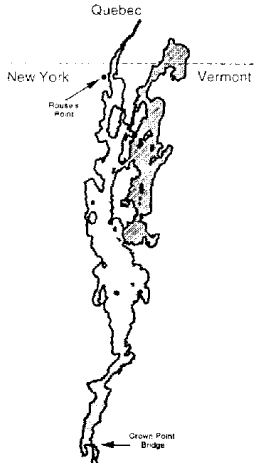 |
Science Frontiers ONLINE No. 121: Jan-Feb 1999 |
|
|
Lake Champlain's Two Seiches
The main body of Lake Champlain is 117 kilometers long, with an average breadth of 6.3 kilometers, and average depth of 29 meters. Although its shoreline in complex, there is a deep channel about 2 kilometers wide with steep sides running lengthwise along the lake floor.
When wind blows across the lake's surface, wind-drag pushes surface water downwind. When the wind stops or changes direction, the piled-up water is freed, and standing waves are set up as the water sloshes back and forth in the lake basin. These waves are called "seiches." Lakes usually have characteristic periods of oscillation. For Lake Champlain, it is 4 hours, with amplitudes measured only in centimeters on the surface of the water.
What makes Lake Champlain of more than usual interest is the presence of a second seiche, an internal phenomenon not visible on the surface. In the summer, Lake Champlain is stratified with a thermocline separating a layer of warm surface water from much colder deep water. You can only "see" the thermocline if you lower a thermometer into the water. This thermocline also exhibits seiches, but they are startlingly different from those on the surface. In Lake Champlain, the period of the internal seiche is 4 days rather than 4 hours. The amplitudes fall between 20 and 40 meters instead of being in the centimeter range. Just a few meters below the lake's surface, conditions are radically different.
(Hunkins, Kenneth, et al; "Numerical Studies of the 4-Day Oscillation of Lake Champlain," Journal of Geophysical Re search, 103:18,425, 1998.)
 |
The seiches under discussion occur in the main part of Lake Champlain on the left. |